
|
|
|
|
|
|
|
|
|
|
Saltwater Aquarium Moray Eels
|
If you are planning on keeping a saltwater eel it will be from the Moray family of Eels. They have minimal maintenance needs but that fierce reputation is well earned. Beyond the fact that they are totally intimidating there are more than 100 eels in the family Muraenidae that are able to be kept in the home aquarium environment. One keeping moray eels must be very careful because all species have those needle-like teeth which can cause severe damage and some victims have lost fingers, thumbs and sometimes more as a result. Though we all get tempted at times, avoid hand feeding any of the moray family. They can move exceedingly quick and with their poor eyesight often bites will occur because they can't readily distinguish between food and your fingers. So we always advise using a feeding stick, or tongs when feeding and finally you must always keep yourself alert to what's going on. Marine Eels have a very good sense of smell but have very poor eye site. Always check on the maximum size of your intended Eel so you can plan your aquarium size. Saltwater Marine eels live in holes or caves in the ocean therefore all saltwater aquarium eels require adequate hiding places which can either be had from using live rock to make tunnels or you can place PVC pipes in the aquarium. We would also include a well-sealed lid to make sure your saltwater eels stay where they belong, in the water. When marine eels open there mouth it is no threat to their owner, they actually breath by opening their jaws to let water flow through their gills. Saltwater eels have a reputation as vicious hunters, but are usually harmless if handled correctly. They are compatible with Triggerfish, Pufferfish, and Larger Angelfish. If well fed we even have had small Damsels be safe in the same tank. Feeding - We recommend feeding twice a week. Also if your Moray Eel doesn't eat do not despair.. It's not unusual for new marine eels to go on a hunger strike for several weeks after introduction to new quarters, so it may be necessary to train the moray onto captive diets. Regular careful feedings using the protection of feeding tongs will produce a trust between your moray and you. It's rare for them to starve to death, so keep plugging away until they feed! Continued on Page 2 |
|
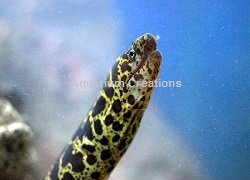 Click to view You Tube Video on the Chainlink Moray Eel
Small $69.99 Medium $89.99 Large $169.99 XLarge $199.99 |
Gymnomuraena zebra, (Fiji) 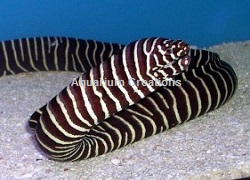
Click to view You Tube Video of Zebra Moray Eel in Maui!
Small $179.99 Medium$199.99 Large $249.99 XLarge $299.99 XXLarge $399.99 Show $699.99 |
Echidna nebulosa 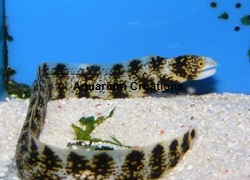 Click to view You Tube Video on the Snowflake Moray Eel
Small $69.99 Medium $89.99 Large $169.99 XLarge $199.99 |
|
Aquarium Conditioned, Black Edge Moray Gymnothorax saxicola 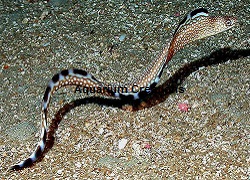 Click to view You Tube Video on the Black Edge Moray Eel
Small $79.99 Medium $99.99 Large $149.99 |
Enchelycore pardalis 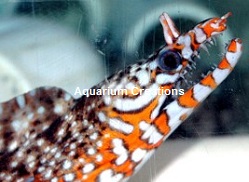 Click to view You Tube Video on the Japanese Dragon Moray Eel
Medium $1119.99 Large $1249.99 XLarge $1399.99 XXLarge $1499.99 |
Gymnothorax favagineus ,Indian Ocean 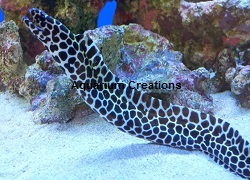 Click to view You Tube Video on the Tessalata Moray Eel
Medium $349.99 Large $449.99 XLarge $599.99 XXLarge $749.99 |
|
|
|
|
Copyright 2020 Aquarium Creations Online Photos are representative of each species. All marine life will be unique and variations should be expected, color and sizes may vary. |